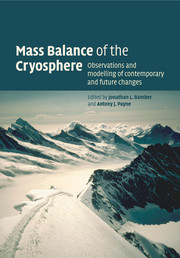Book contents
- Frontmatter
- Contents
- List of contributors
- Foreword
- Preface
- 1 Introduction and background
- Part I Observational techniques and methods
- Part II Modelling techniques and methods
- Part III The mass balance of sea ice
- Part IV The mass balance of the ice sheets
- Part V The mass balance of ice caps and glaciers
- 14 Arctic ice caps and glaciers
- 15 Glaciers and ice caps: historical background and strategies of world-wide monitoring
- 16 Glaciers and the study of climate and sea-level change
- 17 Conclusions, summary and outlook
- Index
- References
16 - Glaciers and the study of climate and sea-level change
Published online by Cambridge University Press: 16 October 2009
- Frontmatter
- Contents
- List of contributors
- Foreword
- Preface
- 1 Introduction and background
- Part I Observational techniques and methods
- Part II Modelling techniques and methods
- Part III The mass balance of sea ice
- Part IV The mass balance of the ice sheets
- Part V The mass balance of ice caps and glaciers
- 14 Arctic ice caps and glaciers
- 15 Glaciers and ice caps: historical background and strategies of world-wide monitoring
- 16 Glaciers and the study of climate and sea-level change
- 17 Conclusions, summary and outlook
- Index
- References
Summary
Introduction
Glacier variations have been of interest for hundreds of years because they can be sensitive indicators of changes in climate. More recently, the role of glacier runoff on the hydrology of mountain regions and the impact of glacier wastage on global sea level have become active areas of scientific effort.
We analyse observational data and the state of health of mountain and sub-polar glaciers for the last several decades, and connection of their changes to climate fluctuations and the global water cycle. We deal here with all glaciers on Earth, excluding the Greenland and Antarctic ice sheets. This analysis is mainly based on our most recently updated time series of mass balance components (Dyurgerov (2002); see http://instaar.colorado.edu/other/occ_papers.html). Every effort has been made to include data from all global sources of information, to check data quality and to eliminate errors.
The quantity and quality of data are far better for the northern hemisphere (especially Europe, Canada, USA and the former Soviet Union (FSU), than for the southern hemisphere. About 70% of the measurements have been carried out in Scandinavia, the Alps, the mountains of the USA, Canada, and the FSU, and the other 30% are sparsely distributed in many other mountain and sub-polar regions (Figure 16.1).
- Type
- Chapter
- Information
- Mass Balance of the CryosphereObservations and Modelling of Contemporary and Future Changes, pp. 579 - 622Publisher: Cambridge University PressPrint publication year: 2004
References
- 12
- Cited by



